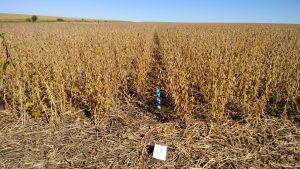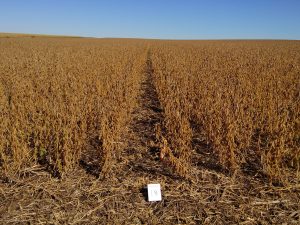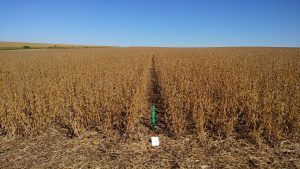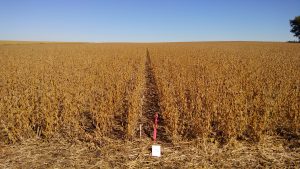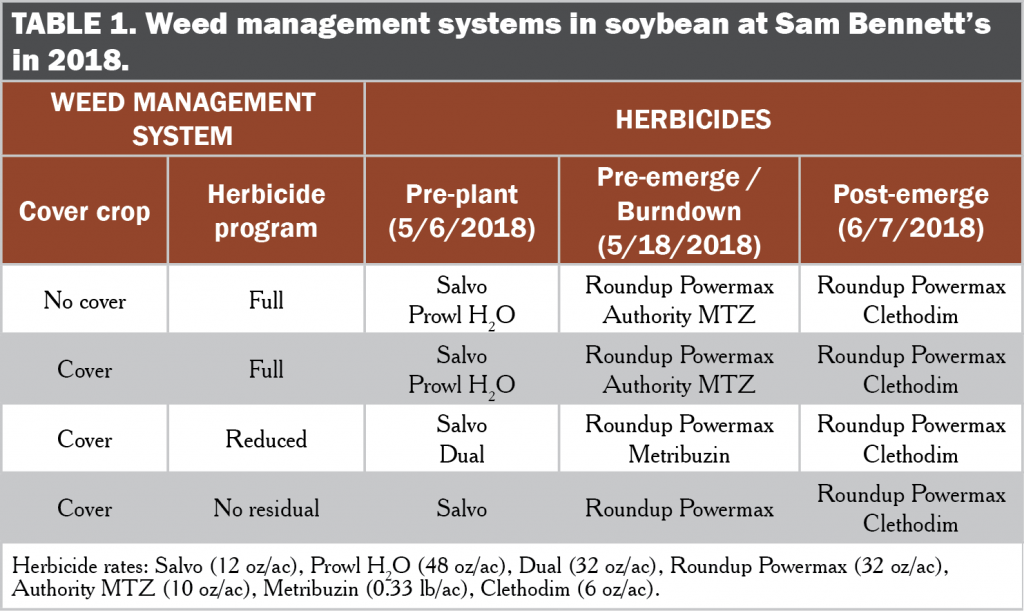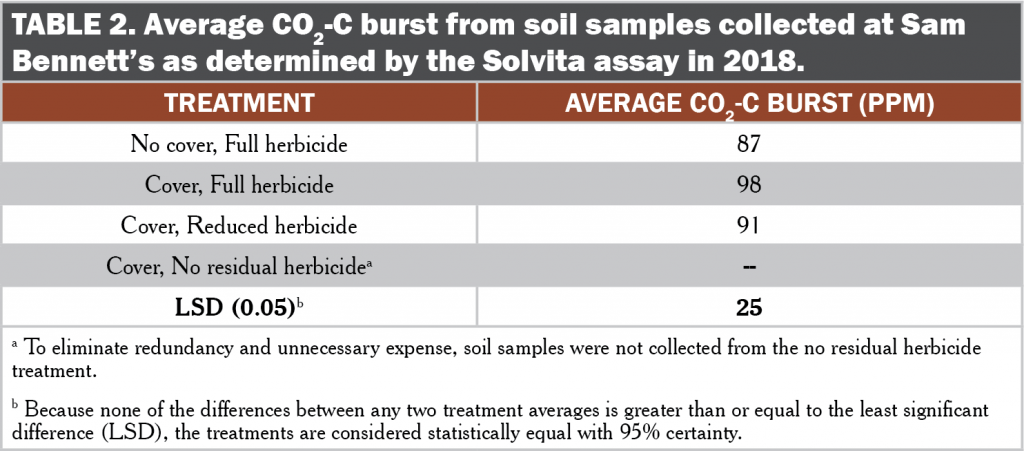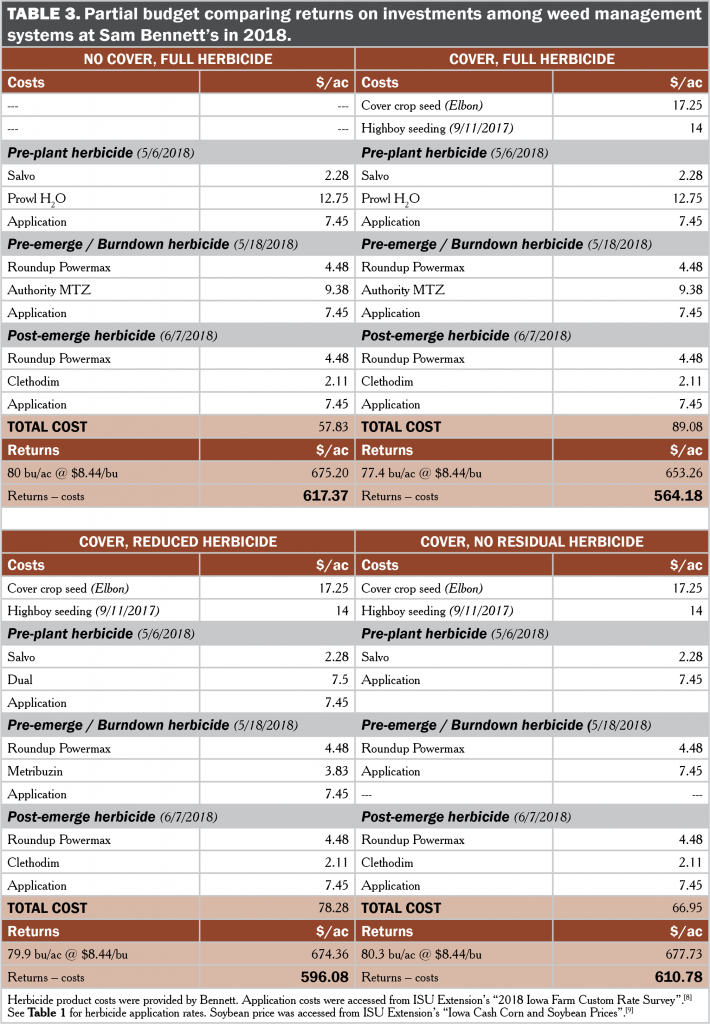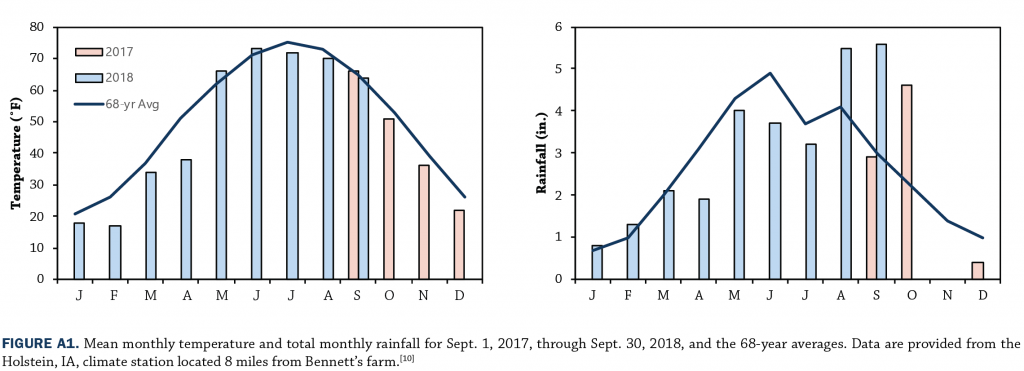By Hayley Nelson and Stefan Gailans
In a Nutshell:
- The costs associated with planting and managing cover crops are a barrier to adoption for many growers despite the benefits to weed control and soil and water quality.
- Farmer-cooperator Sam Bennett investigated differences in weed control, soybean yield and returns on investments among three cover crop treatments with different herbicide programs and a no-cover treatment with a full herbicide program.
- The return on investments was highest for the no-cover treatment; however, the return on investments in the cover crop treatment with no residual herbicides was only $6.59/ac less and did not sacrifice weed control or soybean yields.
- The results of this trial show that while no cover crop treatment reduced herbicide costs by enough to fully pay for the costs of establishing cover crops, growers choosing to implement cover crops may reduce herbicide costs without sacrificing soybean yield or weed control.
Background
Cover crops can provide a variety of on-farm and off-farm benefits, including erosion reduction, weed control and nutrient scavenging.[1] Cereal rye is easy to establish in many soil types and can provide high amounts of biomass needed for effective weed control. Previous studies in Iowa have shown that a cereal rye cover crop can suppress weeds going into soybean and even reduce herbicide passes.[2,3] Despite the benefits of cover crops to water and soil quality and weed control, the direct costs associated with establishing and managing them remain a barrier to adoption for many corn and soybean growers in the Midwest.[4]
Objective: Determine if the use of a cereal rye cover crop could reduce herbicide costs in soybean enough to cover the costs of cover crop establishment without sacrificing weed control or soybean yield.
PHOTOS: Weed pressure in each treatment on Bennett’s farm at the time of harvesting. Clockwise from top left: No-cover, full herbicide program; Cover, full herbicide program; Cover, reduced herbicide program; Cover, no-residual herbicide program.
Sam Bennett has been growing cover crops in his corn and soybean rotation for several years and has observed their positive impacts on his farm’s soil quality and weed control. Seeking to encourage other growers to adopt cover crops, Bennett wondered if the highly effective weed control he observed on his farm from cereal rye would allow him and other growers to save money by reducing their herbicide programs.
Methods
This trial was conducted by Sam Bennett near Galva in Ida County in northwest Iowa.
Treatments included a no-cover treatment with a full herbicide program, a cover crop treatment with a full herbicide program, a cover crop treatment with a reduced herbicide program (lower cost, shorter residual duration), and a cover crop treatment with a no-residual herbicide program. Treatments were replicated four times in 60-ft-wide randomized strips ranging between 1,900 ft and 2,400 ft in length. Treatments are summarized in Table 1.
Cereal rye (var. Elbon) was broadcast in the cover crop treatments with a 60-ft wide highboy seeder on Sept. 11, 2017. The seeding rate was 75 lb/ac (1.4 million seeds/ac) and the previous crop was corn. The following spring, on May 6, 2018, pre-plant herbicides were applied according to each treatment’s specifications (Table 1). On May 16, soybeans were no-till planted in all four treatments in 15-in. rows and at a planting population of 140,000 seeds/ac. Cereal rye biomass was sampled, dried and massed on May 18. On the same day, herbicides were applied for pre-emerge weed control and termination of cereal rye according to each treatment’s specifications (Table 1). A final herbicide application was applied to all four treatments for post-emergent weed control on June 7.
Soil samples were collected to a 6-in. depth on June 13 to compare microbial activity among soils with a cover crop and soils with no cover. To eliminate redundancy and unnecessary expense, soil samples were not collected from all three cover crop treatments. Samples were submitted to AgSource Laboratories (Ellsworth, Iowa) to determine the burst of CO2-C following rewetting of dried soil using the Solvita assay.
Weed pressure was visually scouted in each plot at the time of harvesting soybeans. Soybeans were harvested from the entire 60-ft width of each strip on Sept. 27.
Data were analyzed using JMP Pro 13 (SAS Institute, Inc., Cary, NC). Means separations between treatments are reported using Tukey’s least significant difference (LSD). Statistical significance is reported at the 95% confidence level.
Results and Discussion
Weed control
Weed pressure was consistently low in all four treatments despite experiencing higher weed pressure in the same field in previous years. “From the combine cab, I counted just a few waterhemp plants and virtually no marestail, which has been the big problem weed on this farm before,” Bennett said. This is consistent with previous findings that cereal rye can contribute to suppression of marestail and waterhemp. A two-year study in Kansas found that cereal rye with biomass levels as low as 326 lb/ac improved marestail suppression by 96% compared to a no-cover control.[5] Another study, from Iowa, found that cereal rye biomass levels of 3,200 lb/ac can delay waterhemp emergence until late May, which can provide soybean with a competitive advantage.[2] Cereal rye biomass in this trial was consistent among the cover crop treatments and averaged 3,873 lb/ac. Cold spring temperatures and below-average rainfall in April may have contributed to reduced weed pressure across all treatments in 2018 (Figure A1); however, Bennett noted that some of his other fields without a cover crop did have weed problems at the time of this study.
Soybean yields
Average soybean yield is provided for each treatment in Figure 1. There was no statistical difference in yield among treatments. This is consistent with findings from previous on-farm studies that soybean yields are not affected by a properly managed winter cereal rye cover crop.[6] Soybean yields at Bennett’s far exceeded the five-year Ida County average of 59 bu/ac.[7]
Solvita soil CO2-C burst
The Solvita assay determines soil microbial activity by measuring the amount of CO2-C respired over a 24-hour period from a dried soil sample that has been rewetted and held at an ideal temperature. CO2-C is a partial indicator of soil health. The presence of a cover crop had no effect on the CO2-C burst at Bennett’s (Table 2).
Economic considerations
A partial budget was created to compare returns on investments among treatments (Table 3). The cost of cover crop seed and seeding was $31.25/ac, while herbicide products and application added $35.70/ac to the cost of the no-residual herbicide treatment, $47.03/ac to the reduced-herbicide treatment, and $57.83/ac to the no-cover and cover treatments with full herbicide programs. The return on investments was highest for the no-cover treatment ($617.37/ac). The return on investments compared to the no-cover treatment was $6.59/ac less in the cover crop treatment with a no-residual herbicide program, $21.29/ac less in the cover crop treatment with a reduced herbicide program, and $53.19/ac less in the cover crop treatment with a full herbicide program. Although no treatment was able to cut herbicide costs by enough to fully pay for the cost of implementing cover crops, all treatments suppressed weeds equally well.
Conclusions and Next Steps
At the onset of this trial, Bennett was already a fan of cover crops. “In our no-till/strip-till system, I already see the benefits of the cover crop in soil health, loosening compaction and building organic matter,” Bennett said. However, Bennett understood the financial concerns stopping many growers from using them. Having observed improved weed control in soybean fields with a cover crop, Bennett wanted to see if he could adjust his herbicide program to take advantage of the weed controlling benefits of cereal rye.
In this experiment, Bennett found that no cover crop treatment could reduce herbicide costs enough to fully pay for the costs of cover crops. However, reducing the amount of herbicide applied did not sacrifice weed control or soybean yield, and Bennett suspects he could have further cut herbicide costs in his cover crop fields. “I’ll rely on the rye more than I had been knowing how effective it can be at suppressing weeds. Also, I’ll scout the cover crop fields more intensely to determine if less herbicide is needed in-season versus just prophylactically spraying like we have been with no cover crop,” Bennett said. The results of this trial support the conclusion that when growers seed a cereal rye cover crop ahead of soybeans, herbicide costs can be reduced.
Appendix – Weather Conditions
References
- A. Clark, ed. 2012. Managing Cover Crops Profitably. 3rd ed. Sustainable Agriculture Research and Education program. https://www.sare.org/Learning-Center/Books/Managing-Cover-Crops-Profitably-3rd-Edition (accessed March 2019).
- Anderson, M. and B. Hartzler. 2019. Will a cereal rye cover crop suppress your weeds? Integrated Crop Management. Iowa State University Extension and Outreach. https://crops.extension.iastate.edu/will-cereal-rye-cover-crop-suppress-your-weeds (accessed February 2019).
- Gailans, S., J. Gustafson and J. Boyer. 2016. Cereal Rye Cover Crop Termination Date Ahead of Soybeans, 2016 Update. Practical Farmers of Iowa Cooperators’ Program. https://practicalfarmers.org/research/cereal-rye-cover-crop-termination-date-ahead-of-soybeans-2016-update/https://practicalfarmers.org/research/cereal-rye-cover-crop-termination-date-ahead-of-soybeans-2016-update/ (accessed March 2019).
- Roesch-McNally, G.E., A.D. Basche, J.G. Arbuckle, J.C. Tyndall, F.E. Miguez, T. Bowman and R. Clay. 2017. The trouble with cover crops: Farmers’ experiences with overcoming barriers to adoption. Renewable Agriculture and Food Systems. 33:322–333. https://www.cambridge.org/core/services/aop-cambridge-core/content/view/732DAC57E92E1C9EFC5A451F7EAF454A/S1742170517000096a.pdf/trouble_with_cover_crops_farmers_experiences_with_overcoming_barriers_to_adoption.pdf (accessed March 2019).
- Christenson, A.M. 2015. Cover Crops for Horseweed [Conyza canadensis (L.)] Control Before and During a Soybean Crop. Thesis. Kansas State University. http://krex.k-state.edu/dspace/bitstream/handle/2097/19230/AndiChristenson2015.pdf?sequence=3&isAllowed=y (accessed March 2019).
- Gailans, S., L. Juchems, B. Buman, R. Caviness, J. Funcke, D. Green, R. Juchems, R. Davis, D. Pierce, M. Pokorny, G. Schaefer, J. Sindt, R. Stout, G. Nelson, D. Nelson and K. Tobin. 2019. Winter Cereal Rye Cover Crop Effect on Cash Crop Yield, Year 10. Iowa Learning Farms, Practical Farmers of Iowa Cooperators’ Program. https://practicalfarmers.org/research/winter-cereal-rye-cover-crop-effect-of-cash-crop-yield-year-10/ (accessed March 2019).
- USDA-NASS. 2019. Quick Stats. United States Department of Agriculture National Agricultural Statistics Service. https://quickstats.nass.usda.gov/ (accessed March 2019).
- Plastina, A., A. Johanns and C. Welter. 2018. 2018 Iowa Farm Custom Rate Survey. FM 1698. Ag Decision Maker. Iowa State University Extension and Outreach. https://store.extension.iastate.edu/product/1792 (accessed March 2019).
- Johanns, A. 2019. Iowa Cash Corn and Soybean Prices. A2-11. Ag Decision Maker. Iowa State University Extension and Outreach. https://www.extension.iastate.edu/agdm/crops/pdf/a2-11.pdf (accessed February 2019).
- Iowa Environmental Mesonet. 2019. IEM “Climodat” Reports. Iowa State University Department of Agronomy. http://mesonet.agron.iastate.edu/climodat/ (accessed March 2019).


